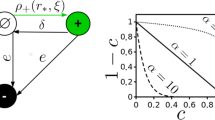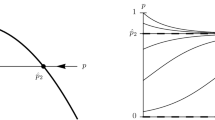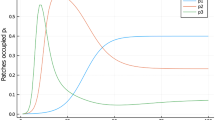Abstract
In coarse-grained environments specialists are generally predicted to dominate. Empirically, however, coexistence with generalists is often observed. We present a simple, but previously unrecognized, mechanism for coexistence of a habitat generalist and a number of habitat specialist species. In our model all species have a metapopulation structure in a landscape consisting of patches of different habitat types, governed by local extinction and colonization. Each specialist is limited to its specific type of habitat. The generalist can use more types of habitat, has a lower local competitive ability but can exploit patches left open by the specialists. Our modeling shows that coexistence is easily possible. The mechanism amounts to a colonization/competition trade-off at the landscape level, where the colonization advantage of the inferior competitor does not arise from a higher colonization rate but from its ability to use more types of habitat. Habitat availability has to be intermediate: when there are few patches of each habitat, only the generalist is able to maintain itself and when there are many patches, high propagule pressure of the specialists excludes the generalist. Habitat selection or temporal variations in relative habitat quality are not necessary for coexistence. Increased niche-width, colonization rate or local competitive ability of the generalist enhances its performance compared to the specialists. Various types of habitat degradation favour generalism. When able to use a broad range of habitats, generalists can generate so much propagule pressure that only a low level of local competitive ability is needed to globally exclude the specialists. Hence, in a reversal of the original problem, the question is why there are so many specialist metapopulations?




Similar content being viewed by others
References
Abrams PA (2006) The prerequisites for and likelihood of generalist-specialist coexistence. Am Nat 167(3):329–342
Adler FR, Mosquera J (2000) Is space necessary? Interference competition and limits to biodiversity. Ecology 81(11):3226–3232
Agosta SJ, Klemens JA (2009) Resource specialization in a phytophagous insect: no evidence for genetically based performance trade-offs across hosts in the field or laboratory. J Evol Biol 22(4):907–912. doi:10.1111/j.1420-9101.2009.01694.x
Armstrong RA (1976) Fugitive species—experiments with fungi and some theoretical considerations. Ecology 57(5):953–963
Bengtsson J, Nilsson SG, Franc A, Menozzi P (2000) Biodiversity, disturbances, ecosystem function and management of European forests. For Ecol Manage 132(1):39–50
Bernays E, Graham M (1988) On the evolution of host specificity in phytophagous arthropods. Ecology 69(4):886–892
Biesmeijer JC, Roberts SPM, Reemer M, Ohlemuller R, Edwards M, Peeters T, Schaffers AP, Potts SG, Kleukers R, Thomas CD, Settele J, Kunin WE (2006) Parallel declines in pollinators and insect-pollinated plants in Britain and the Netherlands. Science 313(5785):351–354
Bonte D, Vandenbroecke N, Lens L, Maelfait JP (2003) Low propensity for aerial dispersal in specialist spiders from fragmented landscapes. Proc R Soc B 270(1524):1601–1607. doi:10.1098/rspb.2003.2432
Brown JH (1984) On the relationship between abundance and distribution of species. Am Nat 124(2):255–279. doi:10.1086/284267
Brown JH (1995) Macroecology. The University of Chicago Press, Chicago
Brown JS (1996) Coevolution and community organization in three habitats. Oikos 75(2):193–206
Brown JS, Pavlovic NB (1992) Evolution in heterogeneous environments—effects of migration on habitat specialization. Evol Ecol 6(5):360–382
Calcagno V, Mouquet N, Jarne P, David P (2006) Coexistence in a metacommunity: the competition-colonization trade-off is not dead. Ecol Lett 9(8):897–907. doi:10.1111/j.1461-0248.2006.00930.x
Caswell H (1978) Predator-mediated coexistence: a nonequilibrium model. Am Nat 112:127–154
Caswell H, Cohen JE (1991) Disturbance, interspecific interaction and diversity in metapopulations. Biol J Linn Soc 42(1–2):193–218
Colles A, Liow LH, Prinzing A (2009) Are specialists at risk under environmental change? Neoecological, paleoecological and phylogenetic approaches. Ecol Lett 12(8):849–863. doi:10.1111/j.1461-0248.2009.01336.x
Comins HN, Hamilton WD, May RM (1980) Evolutionarily stable dispersal strategies. J Theor Biol 82:205–230
Connell JH (1978) Diversity in tropical rainforests and coral reefs. Science 199(4335):1302–1310
Davis ALV (1994) Habitat fragmentation in Southern Africa and distributional response patterns in 5 specialist or generalist dung beetle families (Coleoptera). Afr J Ecol 32(3):192–207
Devictor V, Robert A (2009) Measuring community responses to large-scale disturbance in conservation biogeography. Divers Distrib 15(1):122–130. doi:10.1111/j.1472-4642.2008.00510.x
Devictor V, Julliard R, Jiguet F (2008) Distribution of specialist and generalist species along spatial gradients of habitat disturbance and fragmentation. Oikos 117(4):507–514. doi:10.1111/j.2008.0030-1299.16215.x
Egas M, Dieckmann U, Sabelis MW (2004) Evolution restricts the coexistence of specialists and generalists: the role of trade-off structure. Am Nat 163(4):518–531
Hanski I (ed) (1999) Metapopulation ecology. Oxford University Press, Oxford
Hanski I, Gilpin ME (eds) (1997) Metapopulation biology: ecology, genetics, and evolution. Academic Press, San Diego
Hastings A (1980) Disturbance, coexistence, history, and competition for space. Theor Popul Biol 18:363–373
Hutchinson GE (1951) Copepodology for the ornithologist. Ecology 32:571–577
Jaenike J (1990) Host specialization in phytophagous insects. Annu Rev Ecol Syst 21:243–273
Levins R (1968) Evolution in changing environments: some theoretical explorations. Monographs in population biology. Princeton University Press, Princeton, NJ
Levins R (1969) Some demographic and genetic consequences of environmental heterogeneity for biological control. Bull Entomol Soc Am 15:237–240
Levins R, Culver D (1971) Regional coexistence of species and competition between rare species. Proc Natl Acad Sci USA 6S(6):1246–1248
Marvier M, Kareiva P, Neubert MG (2004) Habitat destruction, fragmentation, and disturbance promote invasion by habitat generalists in a multispecies metapopulation. Risk Anal 24(4):869–878
McKinney ML (1997) Extinction vulnerability and selectivity: combining ecological and paleontological views. Annu Rev Ecol Syst 28:495–516
Menken SBJ, Roessingh P (1998) Evolution of insect-plant associations: sensory perception and receptor modifications direct food specialization and host shifts in phytophagous insects. In: Howard DJ, Berlocher SH (eds) Endless forms. University Press, Oxford, pp 145–156
Menken SBJ, Boomsma JJ, van Nieukerken EJ (2010) Large-scale evolutionary patterns of host plant associations in the Lepidoptera. Evolution 64(4):1098–1119. doi:10.1111/j.1558-5646.2009.00889.x
Morris DW (1992) Scales and costs of habitat selection in heterogeneous landscapes. Evol Ecol 6(5):412–432
Morris DW (1996) Coexistence of specialist and generalist rodents via habitat selection. Ecology 77(8):2352–2364
Nagelkerke CJ, Verboom J, van den Bosch F, van de Wolfshaar K (2002) Time lags in metapopulation responses to landscape change. In: Gutzwiller KJ (ed) Applying landscape ecology in biological conservation. Springer, Berlin, pp 330–354
Nee S, May RM (1992) Dynamics of metapopulations: habitat destruction and competitive coexistence. J Anim Ecol 61:37–40
Nurmi T, Parvinen K (2008) On the evolution of specialization with a mechanistic underpinning in structured metapopulations. Theor Popul Biol 73(2):222–243
Nurmi T, Parvinen K (2011) Joint evolution of specialization and dispersal in structured metapopulations. J Theor Biol 275(1):78–92. doi:10.1016/j.jtbi.2011.01.023
Parvinen K (2006) Evolution of dispersal in a structured metapopulation model in discrete time. Bull Math Biol 68(3):655–678. doi:10.1007/s11538-005-9040-1
Parvinen K, Egas M (2004) Dispersal and the evolution of specialisation in a two-habitat type metapopulation. Theor Popul Biol 66(3):233–248
Poethke HJ, Hovestadt T, Mitesser O (2003) Local extinction and the evolution of dispersal rates: causes and correlations. Am Nat 161(4):631–640
Rausher MD (1988) Is coevolution dead? Ecology 69(4):898–901
Ravigne V, Dieckmann U, Olivieri I (2009) Live where you thrive: joint evolution of habitat choice and local adaptation facilitates specialization and promotes diversity. Am Nat 174(4):E141–E169. doi:10.1086/605369
Rosenzweig ML (1987) Habitat selection as a source of biological diversity. Evol Ecol 1:315–330
Rueffler C, Egas M, Metz JAJ (2006) Evolutionary predictions should be based on individual-level traits. Am Nat 168(5):E148–E162
Thompson JN (ed) (1994) The coevolutionary process. University Press, Chicago
Thompson JN (1996) Trade-offs in larval performance on normal and novel hosts. Entomol Exp Appl 80(1):133–139
Tilman D (1994) Competition and biodiversity in spatially structured habitats. Ecology 75(1):2–16
Tilman D, May RM, Lehman CL, Nowak MA (1994) Habitat destruction and the extinction debt. Nature 371:65–66
Tilman D, Lehman CL, Yin CJ (1997) Habitat destruction, dispersal, and deterministic extinction in competitive communities. Am Nat 149(3):407–435
Turner IM (1996) Species loss in fragments of tropical rain forest: a review of the evidence. J Appl Ecol 33:200–209
Verberk WCEP, van der Velde G, Esselink H (2010) Explaining abundance–occupancy relationships in specialists and generalists: a case study on aquatic macroinvertebrates in standing waters. J Anim Ecol 79(3):589–601. doi:10.1111/j.1365-2656.2010.01660.x
Vieira L, Louzada JNC, Spector S (2008) Effects of degradation and replacement of Southern Brazilian coastal sandy vegetation on the dung beetles (Coleoptera: Scarabaeidae). Biotropica 40(6):719–727. doi:10.1111/j.1744-7429.2008.00432.x
Weiner J, Xiao S (2012) Variation in the degree of specialization can maintain local diversity in model communities. Theor Ecol 5(2):161–166. doi:10.1007/s12080-011-0153-x
Wilson DS, Yoshimura J (1994) On the coexistence of specialists and generalists. Am Nat 144(4):692–707
Acknowledgments
Martijn Egas, Minus van Baalen and Rampal Etienne participated in stimulating discussions and improved an earlier version of the manuscript. The Priority Programme “Biodiversity in Disturbed Ecosystems” of the Netherlands Organization for Scientific Research (NWO) provided funding.
Author information
Authors and Affiliations
Corresponding author
Appendix: critical γ for specialist existence
Appendix: critical γ for specialist existence
Without specialists \( g^{*} = N - \frac{e}{hc} \). Eq. (1a) then gives \( \frac{{{\text{d}}s}}{{{\text{d}}t}} = sc(N - s - \gamma \left[ {N - \frac{e}{hc}} \right]) - es - c\gamma hs\left[ {N - \frac{e}{hc}} \right] \). When N is large the specialist cannot invade (\( \frac{{{\text{d}}s}}{{{\text{d}}t}} < 0{\text{ for small }}s \)) when \( \gamma > \frac{1}{1 + h} \).
Rights and permissions
About this article
Cite this article
Nagelkerke, C.J., Menken, S.B.J. Coexistence of Habitat Specialists and Generalists in Metapopulation Models of Multiple-Habitat Landscapes. Acta Biotheor 61, 467–480 (2013). https://doi.org/10.1007/s10441-013-9186-4
Received:
Accepted:
Published:
Issue Date:
DOI: https://doi.org/10.1007/s10441-013-9186-4




